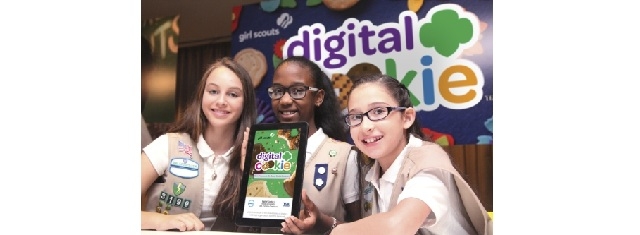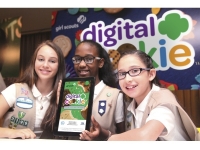Technology
GIRL SCOUTS UNVEILS DIGITAL COOKIE 2.0 LARGEST MULTICHANNEL BUSINESS BY GIRLS
SELLING AND BUYING GIRL SCOUT COOKIES

Girl Scouts show off Digital Cookie 2.0 (Source: Girl Scouts of the USA)
USPA NEWS -
Last year, nearly 160,000 Girl Scouts experienced an update to the Girl Scout Cookie Program: the Digital Cookie platform. With Girl Scouts' first-ever national digital platform, Digital Cookie 1.0 gave girls the opportunity to sell cookies via website or mobile app....
Last year, nearly 160,000 Girl Scouts experienced an update to the Girl Scout Cookie Program: the Digital Cookie platform. With Girl Scouts' first-ever national digital platform, Digital Cookie 1.0 gave girls the opportunity to sell cookies via website or mobile app. This initiative was a first step in preparing girls to be leaders in the high-tech, fast-paced, e-commerce world of today.
As the 2015““2016 cookie season begins, Girl Scouts of the USA (GSUSA) builds on the initial success of Digital Cookie 1.0 by launching Digital Cookie 2.0, with dynamic, engaging, and interactive new tools and fun new upgrades that make learning and selling cookies more exciting and educational for girls.
Digital Cookie 2.0 will provide a more robust, hands-on, and entertaining learning experience, including an enhanced cookie website with fun quizzes, games, videos, and other activities that offer girls opportunities to learn budgeting and resource allocation using a 'spend, save, and give' model.
Girls will also be able to earn all age-appropriate Cookie Business badges through the platform, while exploring ways to help others by investing their earnings back into their communities and practicing Internet safety. Digital Cookie 2.0 is the leading "multichannel" entrepreneurial program for girls in grades K““12, and each girl's experience is customized to her age level.
The national Digital Cookie platform launched in 2014 with two separate ways for girls to market their online cookie business: by inviting customers to visit a personalized cookie website, or by taking in-person orders using a mobile app. Results show girls who diversified their sales methods by combining the Digital Cookie platform with traditional sales methods were more likely to increase their year-over-year sales.
Additional upgrades to the girl-facing website include a goal-setting calculator to help girls track the number of boxes they need to sell to reach their goal (instilling the importance of setting both short- and long-term financial goal) and new ways to organize orders. Girls will be able to further personalize their pages during setup and access improved cookie sales data, with colorful charts showing sales by cookie type and delivery method, as well as week-by-week trends. A fun new arcade game called 'Cookie Booth Bounce' will help girls hone decision-making and budgeting skills, and the new 'Learning to Run a Business' section of the website will include step-by-step guides and insights.
Designed with input from girls, these fun new enhancements use the "science of play" to expand girls' understanding of the business cycle. Girls will be introduced to important new skills about running an e-commerce business, including digital marketing, online money management, revenue projection, and digital customer acquisition and management, all in a safe, hands-on environment.
A 2.7 million strong, 1.9 million girls and 800,000 adults who believe girls can change the world. It began over 100 years ago with one woman, Girl Scouts' founder Juliette Gordon 'Daisy' Low, who believed in the power of every girl. She organized the first Girl Scout troop on March 12, 1912, in Savannah, Georgia, and every year since, Girl Scouts of the USA have made her vision a reality, helping girls discover their strengths, passions, and talents.
Source : Girl Scouts of the USA
Ruby BIRD
http://www.portfolio.uspa24.com/
Yasmina BEDDOU
http://www.yasmina-beddou.uspa24.com/
Source : Girl Scouts of the USA
Ruby BIRD
http://www.portfolio.uspa24.com/
Yasmina BEDDOU
http://www.yasmina-beddou.uspa24.com/
Ruby Bird Yasmina Beddou Largest Multichannel Business By Girls Digital Cookie 2.0 Educational Leader High Tech Dynamic Engaging Interactive Website Mobile App Season Experience
Liability for this article lies with the author, who also holds the copyright. Editorial content from USPA may be quoted on other websites as long as the quote comprises no more than 5% of the entire text, is marked as such and the source is named (via hyperlink).






